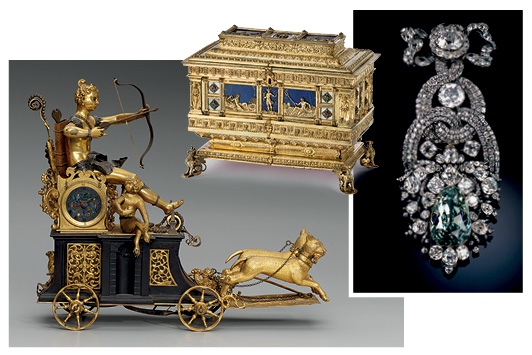
Between 1550 and 1750, it was common among European royals to amass beautiful objects that combined art and technology. Beyond their aesthetic value, these pieces served to bolster the royal families’ status and reputation. Now a selection of such items is on display at the Metropolitan Museum of Art in New York as part of its new “Making Marvels: Science and Splendor at the Courts of Europe” exhibition.
Representing some of the most innovative ideas from the 200-year period the show covers, these prized possessions were stored in treasuries and specially created Kunstkammer — a term meaning “cabinet of curiosities,” used in German-speaking provinces to describe such collections. The approximately 170 items in the exhibit range from clocks, automata, and scientific instruments to decorative objects such as furniture, jewelry, paintings and sculptures.
The inspiration for “Making Marvels” was “the beauty and forward-looking approach of the artisans who made these captivating objects,” according to exhibition curator Wolfram Koeppe, the Marina Kellen French curator in the Met’s department of European sculpture and decorative arts.
“I have a long-term interest in and knowledge about Kunstkammer objects, goldsmith work, mechanical wonders, and furniture,” says Koeppe, who has curated several exhibitions on these topics in the past. Each of the objects in the current display “was made by highly appreciated artisans, using valuable materials, rendered perfectly,” he says. “Every item on view can be included under the motto ‘When only the best will do.’”
Fit for a prince
Princely patrons encouraged the creation of these objects, which fostered the development of innovative ideas and helped lay the groundwork for advancements such as typewriters, computers and digital technology. While they were symbols of power that displayed the wealth and influence of the royal courts, the objects were also a source of entertainment and education.
The exhibition is divided into four sections. The first is dedicated to precious metalwork, showing the exacting quality of workmanship and material worth that went into these pieces. One example: furniture made of silver, a precious metal that many viewed as a status symbol.
The second section covers Kunstkammer objects, including items featuring newly discovered natural materials in finely crafted mounts of gold and silver. Use of nautilus shells, ostrich eggs, Seychelles nuts, coral, ivory and mother of pearl offered the opportunity to broaden knowledge of the natural world.
The third section covers scientific instruments, artisanal tools and equipment that princes would use to develop technical skills. “Objects such as the wire-drawing bench or the lathe show that even royals were involved in crafts in order to become much better rulers of their realm,” explains Koeppe.
The last area is devoted to mechanical marvels such as automata, clockwork pieces with lifelike movements. Among them is The Draughtsman-Writer, which is capable of “writing” three poems and creating three “drawings.”
New to US shores
Some of the pieces have not been seen in the US before.
“Roughly one-third of the works in the exhibition are from the Met,” reports Koeppe. Others are on loan from European and American institutions and collections. Sources in Dresden, Germany, lent six pieces of jewelry and several Kunstkammer items, according to the curator, including the famed Dresden Green diamond. In fact, by virtue of being at the Met, the diamond escaped being stolen in a jewel heist at the Green Vault museum this past November.
“Visiting this show is a unique opportunity to see objects that usually are not allowed to leave their country or simply cannot travel,” Koeppe says, adding that it “offers works of art for a wide range of visitors. I even see children who are fascinated by the glittering objects and the videos that show them in action.”
“Making Marvels: Science and Splendor at the Courts of Europe” will be at the Metropolitan Museum of Art through March 1. metmuseum.org
Image: Yale University Art Gallery; bpk Bildagentur / Kunstgewerbemuseum, Staatliche Museen / Art Resource, NY; bpk Bildagentur / Ruestkammer, Staatliche Kunstsammlungen, Dresden, Germany/Jürgen Karpinski/ Art Resource, NYArticle from the Rapaport Magazine - February 2020. To subscribe click here.